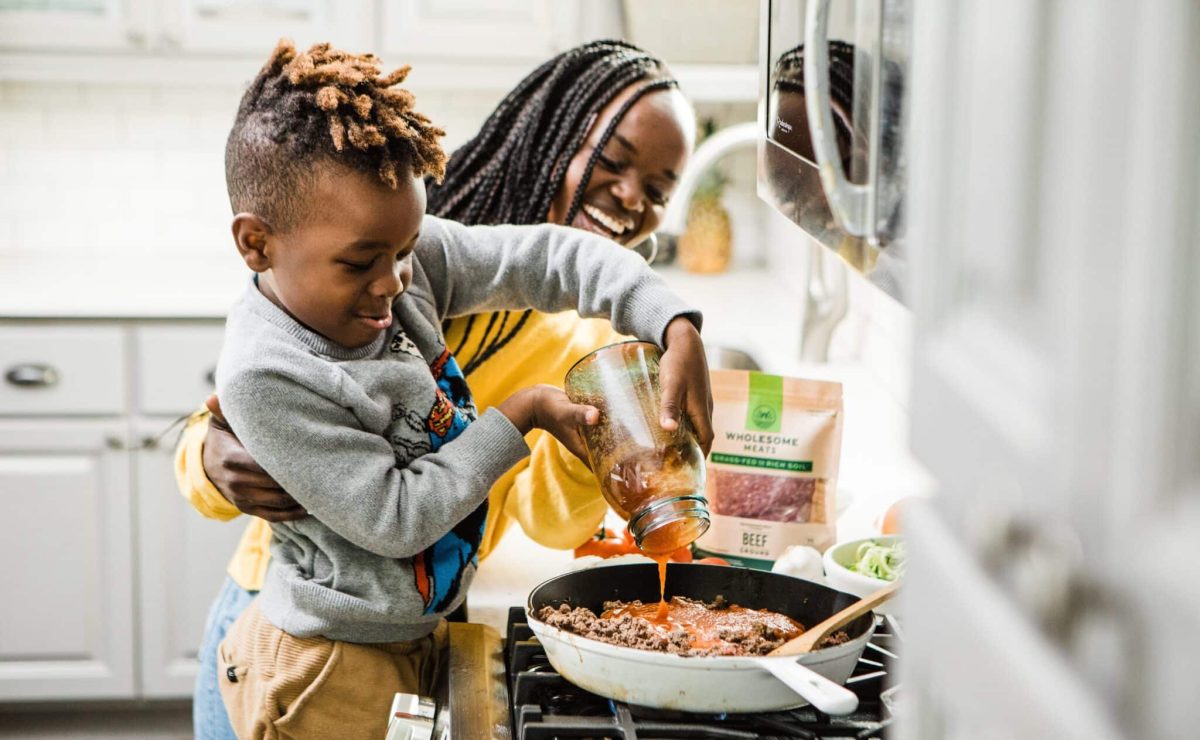If you have a small child, you certainly know how much they like to copy everything you do! They also want to “help” with your daily errands, even though they are just standing in the way. Of course, this is a completely normal (and adorable!) child behavior, and it is good for your child’s development. However, it can also endanger your child; for example, when you are cooking dinner, and your child desperately tries to go near the stoves to “help” you cook. Gas and electric stoves are among the leading causes of burns in children. To prevent this from happening to your child, read on to find the best methods of childproofing gas and electric stoves!
Understanding the Hazards: Gas and Electric Stoves
To better understand the hazards that come with gas and electric stoves, let’s first take a look at the differences between these two stove types. Gas stoves employ open flame that comes out of the burners, and they run on gas. Electric stoves run on electricity, and they have metal heating elements.
In both cases, if your child comes too close to the open flame or heating element, they can get serious burns or even start a fire. To avoid these extremely dangerous scenarios, childproof your stoves. Choose a childproofing technique compatible with the stove type that you have.
Tactic 1: Stove Knob Covers for Gas and Electric Stoves
Stove knobs are placed low enough for even the youngest walking child to reach them. Children like to play with these knobs and turn them around. In the process, they turn on the stovetop or the oven and expose themselves to potentially dangerous temperatures.
That’s why you should buy stove knob covers. These covers are made of heat-resistant plastic that encases the stove knobs. They have a mechanism in place that allows adults to use stove knobs as usual. On the other hand, your child won’t be able to turn around stove knobs.
The advantages of these knob covers are obvious, but they also come with some disadvantages. They break relatively often, and an inquisitive and adept child can learn how to take them off.
Additionally, not every stove knob cover is compatible with every stove, so make sure to choose the right fit for your stove when childproofing gas and electric stoves.
Tactic 2: Stove Guard Barriers
The stove guard barriers are large plates made of heat-resistant plastic, and they are placed like a wall around the stovetop. This way, they prevent children from reaching the stoves, while adults can easily access the stovetops.
Apart from keeping your child from touching the stovetops, these barriers also reduce the splatter. They are easy to install, and they come in several sizes. These barriers are usually attached to the stove through adhesive tapes. A particularly determined and strong child could rip them off.
This is why you need to follow the installation steps and wait for the glue to cure before you let your child anywhere near it. Look for high-quality guard barriers that fit your stove. Occasionally, inspect if the adhesive is still holding everything together.
Tactic 3: Control Panel Shields
Control panel shields are like a combination of the previous two products. Just like stove guard barriers, control panel shields are basically plastic plates. However, instead of covering the stovetop, these shields cover the stove knobs.
Control panel shields will keep your child safe while also enabling the adults to use the stove as they would normally. They are also easy to install, but you need to follow the manufacturer’s instructions.
Also, make sure to find a shield compatible with your stove. Occasionally, test the shield if it still works as it should.
Tactic 4: Use Appliance Locks and Latches for Childproofing Gas and Electric Stoves
Appliance locks and latches are a great way to childproof various appliances in your home, including the stoves. There are locks and latches specialized for every type of appliance. For example, stove locks and latches will prevent your child from opening the oven and turning the stove knobs.
When installing these locks and latches, make sure to choose the ones that are compatible with your stove. Follow the manufacturer’s installation guide. When properly installed, these locks and latches will keep your child safe.
However, before you choose locks and latches as your childproofing tactic, keep in mind that they also come with some drawbacks. Some users complain that they can damage the stove and that they are inconvenient for long-term use.
Tactic 5: Burner Covers for Gas Stoves
As their name suggests, burner covers cover the burners when they are not in use. These covers can prevent accidental burns in cases when burners are still hot, even when they are not in use.
Also, if a gas burner gets turned on by accident, these burner covers can prevent someone from touching the open flame. Burner covers are heat resistant, and they can withstand temperatures up to 500 F, given that they are not directly touching the flame.
Make sure to choose the burner covers that fit your stove and that you install them properly. Clean them regularly and put them away when you are not using them.
Tactic 6: While Childproofing Gas and Electric Stoves Rearrange Pot and Pan Placement
Another danger regarding the stoves and stovetops lies in knocking over pots and pans filled with hot food and liquids. This can result in serious scald injuries in your child, which makes it another thing to consider.
Fortunately, you can do some things to minimize the danger. For example, use back burners instead of front burners. This will make it harder for your child to touch hot burners, pans, and pots. Also, always turn the pot and pan handles inward so that your child can’t grab them and spill the hot contents on themselves.
With these simple tricks, you can significantly reduce the danger of spilling hot liquids and foods on your child. However, keep in mind that pot and pan placement isn’t 100% effective but in combination with these other methods, it works well!
Tactic 7: Anti-Tip Brackets for Freestanding Stoves
If your stove is freestanding, you need to ensure it can’t tip over and fall, especially if your child is nearby. To do that, you can buy and install anti-tip brackets. Simply attach them to the floor, and they will keep your stove in place.
These brackets are made of durable metal, and they are easy to install. Some people don’t like them because they can damage the floor. However, that doesn’t happen so often, and even when it does, it is a small price to pay for the safety of your child.
Make sure to choose high-quality brackets, and install them properly, according to the manufacturer’s instructions. If you notice any breakage or bending, don’t ignore it and replace it asap.
Tactic 8: Using Cord Shorteners for Electric Stoves
Electrical appliances often come with long cords. This has its benefits, but it also presents a safety hazard, especially around small children and pets. For example, this cord can get damaged, and when your child touches it, they can get electrocuted.
Cord shorteners will prevent your stove cords from lying around and attracting your child’s attention. In short, they keep electric stove cords out of children’s reach. These cord shorteners also increase the aesthetic appeal of your home because they reduce the clutter caused by cords.
However, cord shorteners reduce the mobility of your stove and other appliances. Also, if not installed properly, they can damage the cord. Finally, cord shorteners don’t fully prevent your child from touching the cords and cables, so don’t rely fully on this product.
Tactic 9: Establishing a Designated “Kid-Free” Zone
Apart from buying various childproofing products, there are other things you can do to increase your child’s safety around the stoves. When working towards childproofing gas and electric stoves, you can start by creating a safe distance between your child and the appliances!
As soon as your child is old enough to understand, teach them to avoid coming too close to the stove. Explain that it is a dangerous area, not a toy and that they should stay in the safe zone. You can use visual cues, such as floor mats or tape, to help your child differentiate between safe and dangerous areas.
Tactic 10: Installing an Automatic Stove Shut-Off Device
Thanks to modern technologies, you can use a simple device to turn off your stove automatically after a certain time. This is great because it prevents unattended cooking and gas leaks. It is particularly handy for busy parents that might forget to turn off the stovetop.
These devices will further increase the safety of your kitchen. Of course, that doesn’t mean that you should be reckless and leave the stovetop turned on or let your child play with the stove. While these technology-based solutions are great, you should never fully rely on them.
They come with some drawbacks, such as complex installation as well as high installation and maintenance costs. Also, like any other device, these devices can malfunction at the worst moment possible.
If you decide to install one such device despite potential drawbacks, make sure to get a device from a reputable manufacturer with good reviews, compatible with your stove and your needs.
Establishing Safe Cooking Habits
In general, setting boundaries with your child is one of the best things you will do for them. This also applies to kitchen and stove safety. While they are still young, teach your child about stove safety using age-appropriate language and examples. Education is the first step for childproofing gas and electric stoves!
If you need to look after your child while you are cooking, create a secure environment for them. Let them play in a corner or other part of the kitchen where they will be as far from the stove as possible. You should still be able to see them and what they are doing.
Regular Maintenance and Safety Checks
To further reduce the danger, keep your stove in perfect condition. Check if the electrical cords or gas pipes have any signs of damage and replace them. Any other broken, scratched, or otherwise damaged parts can be safety hazards for you and your child, so don’t ignore them.
Also, if you installed some of the childproofing devices, inspect them for wear and tear regularly. If you notice any sign of damage, replace the device. During the installation, make sure to follow the installation guide for optimal protection.
A Safe Kitchen for Your Little Sous Chef by Childproofing Gas and Electric Stoves
Sooner or later, your child will become interested in kitchen appliances, including the stove. Gas and electric stoves can be safety hazards for your child, so you need to childproof them until your child is old enough.
This article has shown you the best methods for childproofing gas and electric stoves. It is up to you to decide which method will work best for your stove. You don’t have to limit yourself and choose only one method. If it works for you, employ several methods at once.
Finally, here is a reminder that you should never fully rely on various devices. Always supervise your child when they play in and around the kitchen. As they grow up, teach them about kitchen safety and the potential dangers. We also have some tips for you and your little one on childproofing your locks and doors.
Over the years, your child will slowly learn how to use the stove responsibly, but until then, use our tips to create a safe kitchen for your little sous chef!

Be aware, and stay safe!
Found this article useful? please share it with your friends!
And to stay up to date with our latest content, don’t forget to follow us on Facebook!




